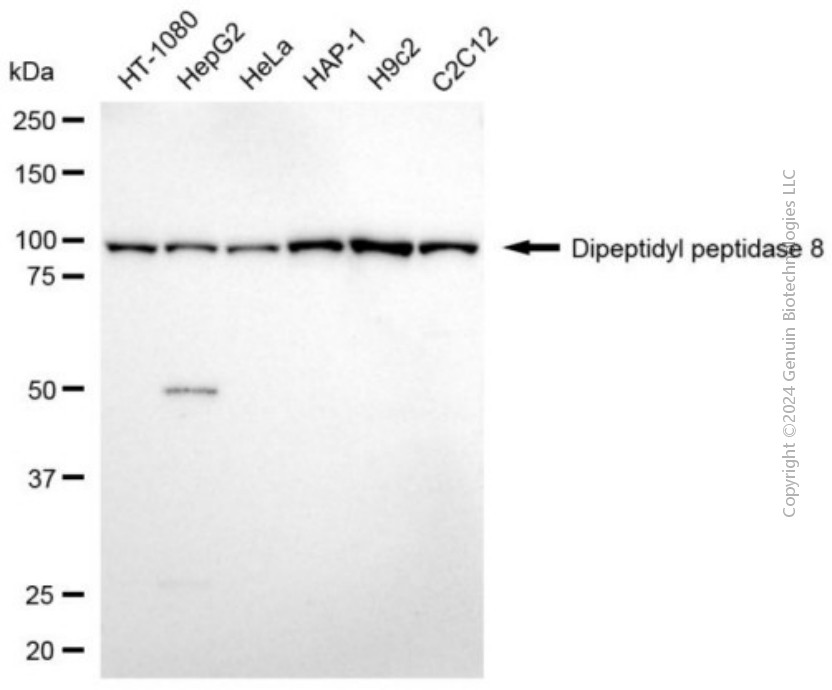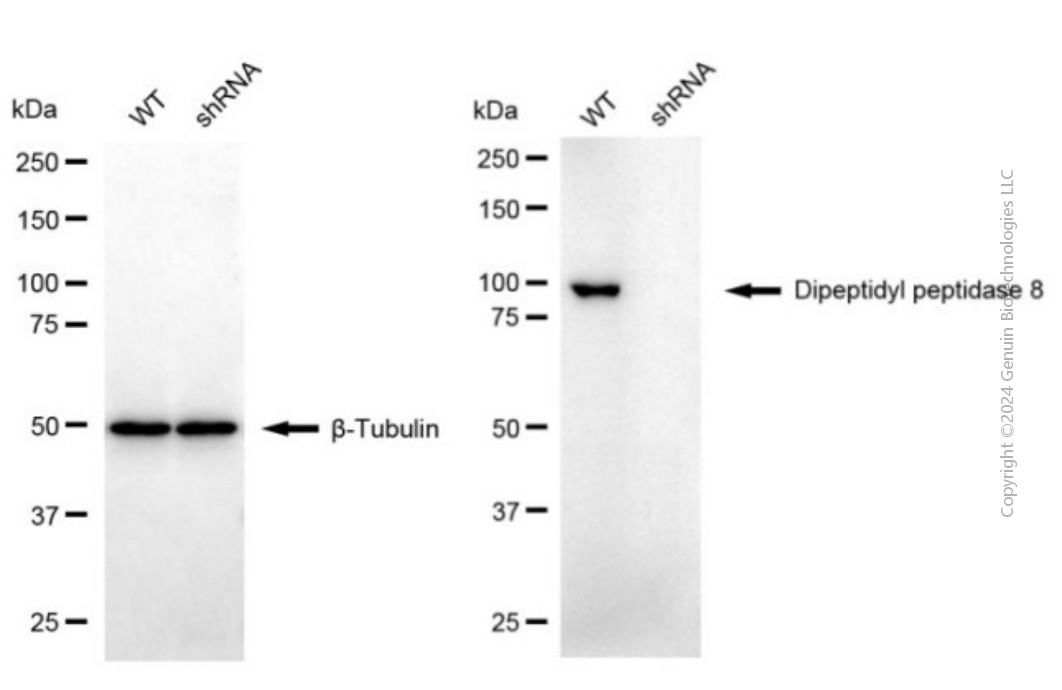KD-Validated Anti-DPP8 Mouse Monoclonal Antibody
Mouse monoclonal antibody
- SPECIFICATION
- CITATIONS
- PROTOCOLS
- BACKGROUND

Application
| WB |
|---|---|
| Primary Accession | Q6V1X1 |
| Reactivity | Rat, Human, Mouse |
| Clonality | Monoclonal |
| Isotype | Mouse IgG1 |
| Clone Names | 24GB8195 |
| Calculated MW | Predicted, 103 kDa, observed, 103 kDa |
| Gene Name | DPP8 |
| Aliases | DPP8; Dipeptidyl Peptidase 8; DPRP1; DP8; Dipeptidyl Peptidase VIII; Prolyl Dipeptidase DPP8; MSTP141; Dipeptidyl Peptidase IV-Related Protein 1; FLJ14920; FLJ20283; MGC26191; DPP VIII; DPRP-1; Dipeptidyl Peptidase IV-Related Protein-1; Dipeptidyl-Peptidase 8; Dipeptidylpeptidase 8; EC 3.4.14.5; MSTP097; MSTP135; MST097 |
| Immunogen | Recombinant protein of human DPP8 |
| Gene ID | 54878 |
|---|---|
| Other Names | Dipeptidyl peptidase 8, DP8, 3.4.14.5, Dipeptidyl peptidase IV-related protein 1, DPRP-1, Dipeptidyl peptidase VIII, DPP VIII, Prolyl dipeptidase DPP8, DPP8 {ECO:0000303|PubMed:11012666, ECO:0000312|HGNC:HGNC:16490} |
| Name | DPP8 {ECO:0000303|PubMed:11012666, ECO:0000312|HGNC:HGNC:16490} |
|---|---|
| Function | Dipeptidyl peptidase that cleaves off N-terminal dipeptides from proteins having a Pro or Ala residue at position 2 (PubMed:11012666, PubMed:12534281, PubMed:12662155, PubMed:15039077, PubMed:15664838, PubMed:20536396, PubMed:29382749). Acts as a key inhibitor of caspase-1-dependent monocyte and macrophage pyroptosis in resting cells by preventing activation of NLRP1 and CARD8 (PubMed:27820798, PubMed:29967349, PubMed:32796818). Sequesters the cleaved C-terminal part of NLRP1 and CARD8, which respectively constitute the active part of the NLRP1 and CARD8 inflammasomes, in a ternary complex, thereby preventing their oligomerization and activation (PubMed:33731929, PubMed:33731932, PubMed:34019797). The dipeptidyl peptidase activity is required to suppress NLRP1 and CARD8; however, neither NLRP1 nor CARD8 are bona fide substrates of DPP8, suggesting the existence of substrate(s) required for NLRP1 and CARD8 inhibition (By similarity). |
| Cellular Location | Cytoplasm |
| Tissue Location | Ubiquitously expressed, with highest levels in testis, placenta, prostate, muscle and brain |

Thousands of laboratories across the world have published research that depended on the performance of antibodies from Abcepta to advance their research. Check out links to articles that cite our products in major peer-reviewed journals, organized by research category.
info@abcepta.com, and receive a free "I Love Antibodies" mug.
Provided below are standard protocols that you may find useful for product applications.
If you have used an Abcepta product and would like to share how it has performed, please click on the "Submit Review" button and provide the requested information. Our staff will examine and post your review and contact you if needed.
If you have any additional inquiries please email technical services at tech@abcepta.com.














 Foundational characteristics of cancer include proliferation, angiogenesis, migration, evasion of apoptosis, and cellular immortality. Find key markers for these cellular processes and antibodies to detect them.
Foundational characteristics of cancer include proliferation, angiogenesis, migration, evasion of apoptosis, and cellular immortality. Find key markers for these cellular processes and antibodies to detect them. The SUMOplot™ Analysis Program predicts and scores sumoylation sites in your protein. SUMOylation is a post-translational modification involved in various cellular processes, such as nuclear-cytosolic transport, transcriptional regulation, apoptosis, protein stability, response to stress, and progression through the cell cycle.
The SUMOplot™ Analysis Program predicts and scores sumoylation sites in your protein. SUMOylation is a post-translational modification involved in various cellular processes, such as nuclear-cytosolic transport, transcriptional regulation, apoptosis, protein stability, response to stress, and progression through the cell cycle. The Autophagy Receptor Motif Plotter predicts and scores autophagy receptor binding sites in your protein. Identifying proteins connected to this pathway is critical to understanding the role of autophagy in physiological as well as pathological processes such as development, differentiation, neurodegenerative diseases, stress, infection, and cancer.
The Autophagy Receptor Motif Plotter predicts and scores autophagy receptor binding sites in your protein. Identifying proteins connected to this pathway is critical to understanding the role of autophagy in physiological as well as pathological processes such as development, differentiation, neurodegenerative diseases, stress, infection, and cancer.



